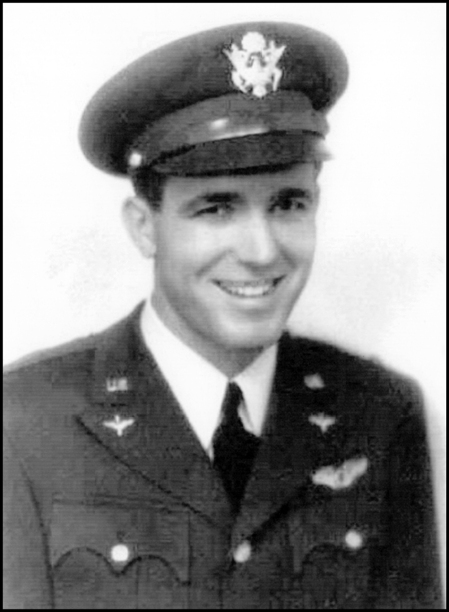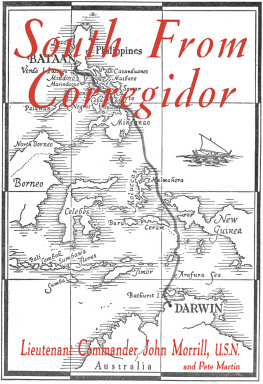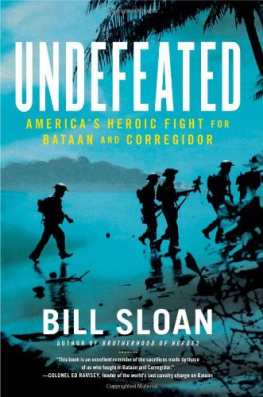One of the best of the war-escape booksthe more impressive because of its simplicity.
San Francisco Call-Bulletin
an incredible, fascinating account
Virginia Kirkus Service
This strange, true adventure of World War II is both interesting reading and a tribute to the American fighting man.
Pittsburgh Courier
exciting, fast moving
Chicago Dailey Calumet
World War II has provided us with many bizarre escape stories, but none can surpass Escape from Corregidor .
The Jackson Sun
Escape from
CORREGIDOR
Edgar D. Whitcomb

AuthorHouse
1663 Liberty Drive
Bloomington, IN 47403
www.authorhouse.com
Phone: 1-800-839-8640
1958, 2012 Edgar D. Whitcomb. All rights reserved.
No part of this book may be reproduced, stored in a retrieval system, or transmitted by any means without the written permission of the author.
Published by AuthorHouse 8/28/2012
ISBN: 978-1-4772-6302-0 (e)
ISBN: 978-1-4772-6303-7 (hc)
ISBN: 978-1-4772-6304-4 (sc)
Library of Congress Control Number: 2012915231
Any people depicted in stock imagery provided by Thinkstock are models,
and such images are being used for illustrative purposes only.
Certain stock imagery Thinkstock.
Because of the dynamic nature of the Internet, any web addresses or links contained in this book may have changed since publication and may no longer be valid. The views expressed in this work are solely those of the author and do not necessarily reflect the views of the publisher, and the publisher hereby disclaims any responsibility for them.
CONTENTS
This book is dedicated to the defenders
of Bataan and Corregidor.
I have read Escape from Corregidor with a great deal of interest. This straightforward narrative of the trails and vicissitudes of an American boy caught in the defense of the Philippines early in World War II is that of thousands of other American boys similarly enmeshed, including my son, Bill Harris. It was he who made the all-night swim with the author through the shark-infested waters from Corregidor to Bataan and escape.
It paints the picture of the transition of a normal American boy from an average American home to war at its worst. The picture on the canvas shows:
The young navigators early enthusiasm and pride in being a member of the longest mass flight in history of B-17s from the United States to the Philippines.
The frustration of my old friend, Gene Eubank, the commander of this group of B-17s, as he stood in the unprotected open and saw his group disintegrate before his eyes from a Japanese attack.
The hope and belief that our great country would send succor to this little band of trapped warriors in the Philippines.
The realization that no help was coming and that only death or capture lay ahead.
Then, after the surrender on Corregidor, the determination to escape, followed by the successful swimming of the waters separating Corregidor from the mainland, and temporary freedom.
Such are the scenes which, when assembled, give a vivid picture of how an American civilian adjusts himself to a totally foreign way of livingthat of warmeets almost insurmountable obstacles, hurdles them with determination, and keeps going forward.
This ability of our American youth to adjust from the quiet American home to the hardships and grimness of the battlefield is a quality that I have often marveled at and long admired. He has been described in some quarters as soft and not able to take it. However, it has been my observation that, given the proper tools and training, he is the equal, perhaps the superior, of any fighting man in the world. Maybe it is our competitive sports and competitive way of life that develop this quality, but whatever it is, the American serviceman is tops in my book.
An item of especial interest to me was noted. The author makes this statement: Many of the men had never so much as fired an Army rifle, and I was one of them. He was referring to some Air Force personnel ordered to take infantry training on Bataan for defense purposes. This matter of whether or not to train Marine Corps aviation personnel in the use of the rifle has been debated in our Corps for years. However, it has always been decided that they should be so trained, pilots and everybody. In Korea we were awfully glad that we had this training. In North Korea, when things were rough, we didnt have anybody except aviation personnel to protect our air installations. We were glad then that we knew how to use the rifle. I shall go further and add that I consider it the heritage of every American boy to be able to shoot a rifle and to do it well.
The latter part of the book deals with the trials and problems of the author after his recapture, and his ultimate return to the United States. Some of the happenings are fantastic and just couldnt happen, yet they did.
The culmination of this saga is the authors return to the Philippines as a member of a medium bomber group and his participation in bombing attacks on the enemy.
Some of the readers may wonder what happened to my son, Bill Harris, after he and the author separated. He and several companions were able to sail as far south as Morotai Island on their way to Australia. Only one more leg remained to complete their journey. Unfortunately, the natives betrayed them there, and they were turned over to the Japanese. This was in September, 1943. From there Bill was flown to Japan and stayed in Japanese prison camps until the end of the war. He had the satisfaction of observing the Japanese surrender on the U.S.S. Missouri in August, 1945, and I had the pleasure of flying him from Guam to Washington and freedom. Later he was killed, leading his battalion in the Chosan Reservoir operation in Korea, in December, 1950.
Aside from the very interesting reading offered by this book, I feel that it cannot help stirring up a quiet pride in the breast of every American parent whose boy has participated in our wars. These boys asked for so little and gave so much.
Lt. General Field Harris, u.s.m.c., ret.
Cadet Edgar D. Whitcomb, 1940.

T he four engines of our B-17 wind up with a thundering roar as we lumber down the runway on Hamilton Field, California. Pencils, books, maps, and everything loose slide to the back of the table, and the force of the acceleration takes hold of my body as the plane lunges forward. Runway lights flash past faster and faster, until at last I feel light and breathing becomes easier. We are off the ground; and through the plastic nose of the plane, I can see the lights of the bay, the boats and the bridges of San Francisco. I press my face to the cold window to drink up these last precious glimpses of the U.S.A. It is October 16, 1941, and we are on our way to a two-year tour with the Air Corps in the Philippine Islands. It will be a long time before we see this again. We may never see it again.
Little do I know that I am starting on a strange trip around the world, perhaps unlike that experienced by any other person that I will be captured by the enemy that I will escape and be captured again that I will be accused of being a deserter and returned to the U.S.A. with a name not even my own or that I will have to fly from San Francisco again before I can take an active part in the war.
Seconds after the anti-aircraft searchlights salute us high above the long string of lights which I recognize as the Golden Gate Bridge, we plunge into a wall of total blackness. With the darkness comes torrential rain and turbulence; the aircraft begins to pitch and toss, and loose gear falls to the floor.
Next page












